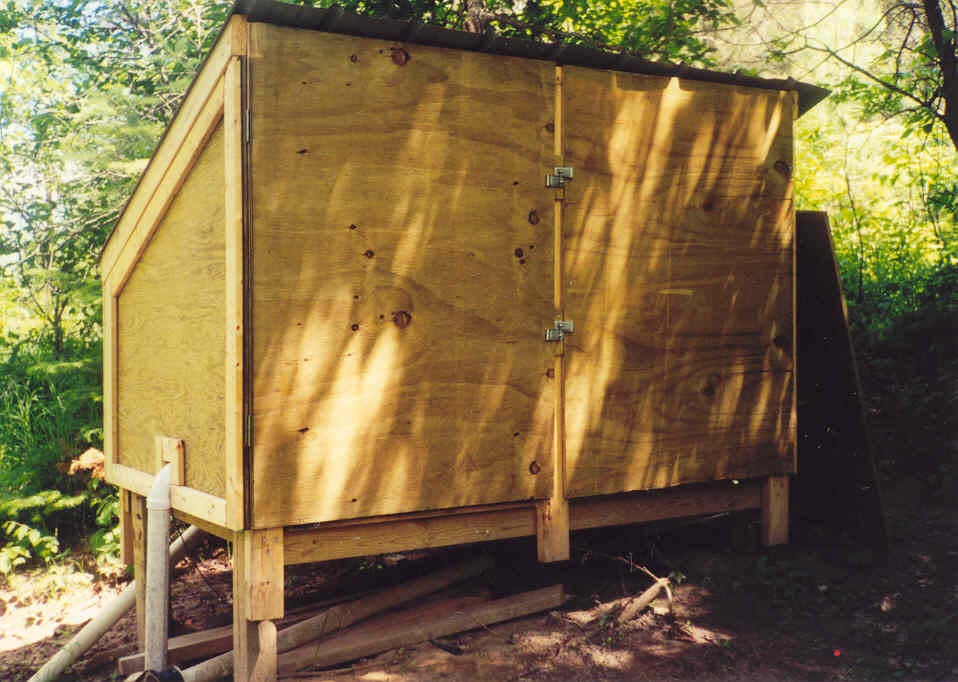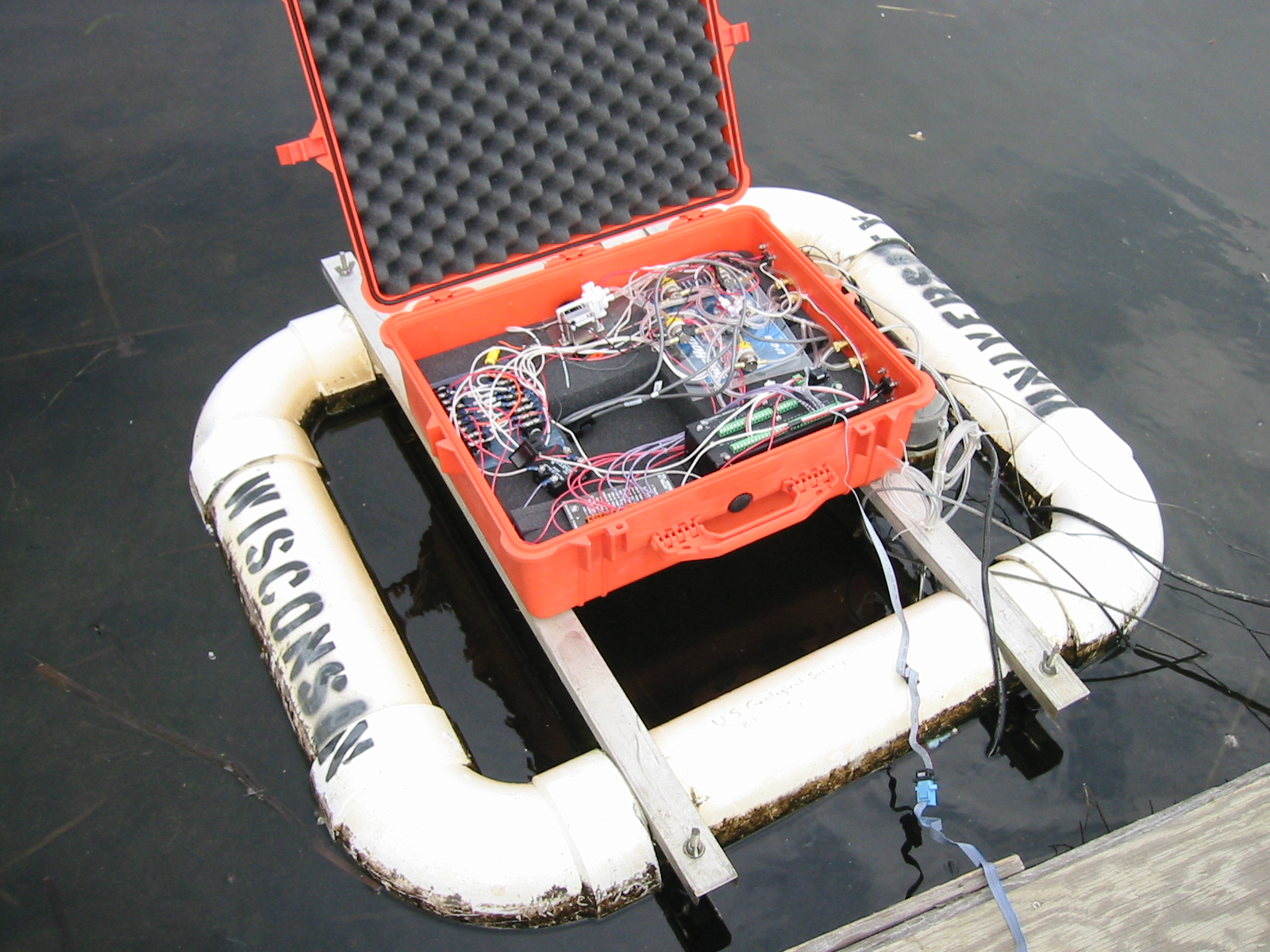 chemical and biological processes along the Shingobee River
chemical and biological processes along the Shingobee River
Current interdisciplinary research is focused on three main topics.
 chemical and biological processes along the Shingobee River
chemical and biological processes along the Shingobee River|
SHAEP receives funding from USGS Ground-water recharge project The Shingobee site will be part of a study on the amount and spatial variability of recharge to ground water in northern Minnesota. This study is titled "Temporal and Spatial Variability in Ground-Water Recharge in Upper Mississippi Basin, Minnesota," and the principal investigators are Geoff Delin (USGS Minnesota District), Rick Healy (USGS, NRP, Denver, Colorado), John Nimmo (USGS, NRP, Menlo Park, California), and Don Rosenberry (USGS, NRP, Denver, Colorado). |



Refinement of hydrologic budget for Shingobee Lake (Rosenberry, Winter)


The recently constructed "Great Wall of Shingobee" at the outlet to Shingobee Lake is working well to allow us to make accurate measurements of stream discharge from Shingobee Lake, rather than making measurements several kilometers downstream on the Shingobee River. Dallas Hudson has made a Herculean effort to keep the downstream beaver dam at bay so that our stage-discharge relationship remains stable. This will allow us to determine much more accurate water and chemical budgets for the lake.
Temporal and spatial variability in discharge of springs (Rosenberry, Hudson)
Ground-water discharge to Shingobee Lake via numerous near-shore springs continues to vary over time in ways that are not always related to weather or lake stage. We are in the process of collecting water-quality samples from several of the springs in an effort to determine ages and flow paths for ground water discharging from the springs.



Source of carbon to Shingobee Lake (Striegl et al.) Gas-flux research (Dornblaser et al.)

|
Rob Striegl and Mark Dornblaser continue to home in on quantifying several of the carbon fluxes associated with Williams and Shingobee lakes. This summer a gas-flux system was installed at Williams Lake that is identical to the system that has been running at Shingobee Lake since 2001. Several gremlins have been identified and dispelled, thanks to Dallas' vigilance and considerable patience, data collection has become much more reliable. |

Paul Schuster and colleagues recently published a paper in Hydrological Processes where they characterized and contrasted the chemical characteristics of the shallow, near-shore sediments of Williams Lake in an area where ground water discharges to the lake, and another area where lake water flows to the ground-water system.
Isotope plumes (Reddy et al.)
Mike Reddy and colleagues are working on use of annual variation of the oxygen isotopic signature of precipitation over a period of several years during the early 1990's. This signature is retained along ground water flow paths and can be described using a mathematical model (i.e., a sine function), allowing age dating of shallow ground water in the watershed. Mean residence times of ground water in two shallow wells near Williams Lake was about 1 and 16 years, suggesting significant aquifer heterogeneity.
Paleolimnology (Dean et al.)Walter Dean and colleagues have a paper coming out in the journal Ground Water where they report that discharge of iron and manganese via ground water can impact the nutrient budget of Shingobee Lake.
Glacial mapping (Melchior, in review) Survey of vegetation type related to hydrologic setting (Melchior, Rosenberry, Winter)
Bob Melchior has completed his glacial map of the Shingobee watershed and it currently is in review for publication as a USGS report. Bob continues his work at the Shingobee watershed, now focusing on the distribution of plants related to proximity to the water table and areas of ground-water discharge.
Local scale ET measurements (Daanen, University of Minnesota)
Ronnie Daanen from the University of Minnesota recently completed his Ph.D. dissertation on the spatial variability of ground-water recharge and evapotranspiration at Chase's Marsh, located between Williams and Mary Lakes. His results soon will be available from the University of Minnesota.
Mercury (Hg) accumulation in fish (Jeremiason, Minnesota Pollution Control Agency, Hudson, USGS)

| Jeff Jeremiason recently left Minnesota Pollution Control Agency and accepted a position at Gustavus Adolphus College. However, before he left Jeff worked to obtain a permit to conduct a study at the Shingobee site that will relate fish growth to mercury accumulation. This will require catch and release of tagged fish multiple times to observe the change in mercury in the same fish over time. Dallas Hudson's excellent fishing skills will be a bonus for this project. |
Hg methylation related to nutrient fluxes (USGS District (Menheer)), MPCA (Jeremiason), Minnesota Department of Health (Herbrandson), USGS NRP (Rosenberry, Krabbenhoft)
Mike Menheer, USGS Minnesota District office, and colleagues continue their effort to develop a benthic flux chamber with which they will conduct research on the relationship between ground-water discharge and methylation of mercury.
Crow Wing Environmental Protection Association nutrient/clearcut study (Rosenberry et al., CWEPA foundation)
Data collection is just about finished on a long-term study to assess the impact of a hillslope clearcut on nutrient fluxes to Shingobee Lake.
Denitrification (Korom, Schlag (University of North Dakota))

|
Scot Korom and Alan Schlag from the University of North Dakota have been studying denitrification by shallow ground water across northern Minnesota and northeastern North Dakota. The Shingobee site is one of their long-term study sites. They installed several wells at the Shingobee site a couple of years ago, and they continued their data collection effort this field season. |
Emi Ito (University of Minnesosta) and colleagues are using the Shingobee site as a calibration site for developing a meso-scale climate model that links ground water and evapotranspiration.
Research of lakes, streams and wetlands in a small-watershed setting
Watershed-scale research has been a significant component of hydrologic and ecological disciplines for many decades, and small-watershed studies have been especially common and useful because of their scale. It is much easier to quantify processes, assess heterogeneities and extrapolations of results, and scale those results when studying a watershed that is relatively small. The Upper Shingobee watershed is only 28 square kilometers in area and much of the research is focused on subwatersheds within the Shingobee watershed. An overview of research highlights from studies conducted at Williams Lake, Shingobee Lake, the Shingobee River upstream of Shingobee Lake, and the Little Shingobee Fen, will be presented at the First Interagency Conference on Research in the Watersheds during Fall 2003, and the accompanying paper will be available at this website.
Available data from the Shingobee site
Much data has been collected from the Shingobee site since its inception. Some data are collected only once or infrequently during synoptic studies for special research interests. However some data are collected during regular intervals and include:
While some data have not yet been processed, checked for errors, or analyzed, many of these data are available upon request. Please contact Renee Parkhurst rparkhur@usgs.gov with request for climate, water-chemistry or hydrology data.
See also IRI News - Archives for more information

